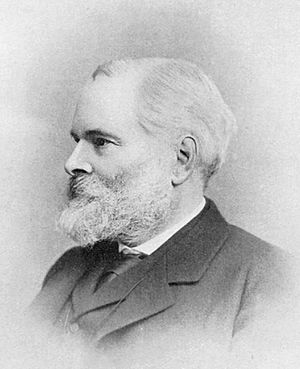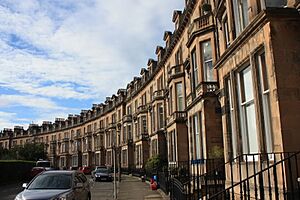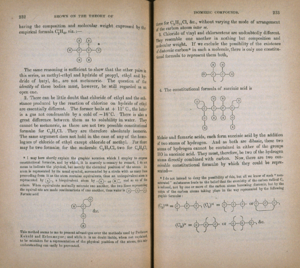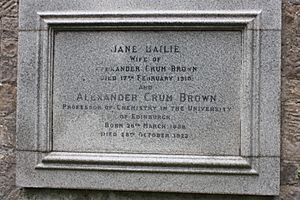Alexander Crum Brown facts for kids
Quick facts for kids
Alexander Crum Brown
|
|
|---|---|
 |
|
| Born | 26 March 1838 Edinburgh, Scotland
|
| Died | 28 October 1922 (aged 84) Edinburgh, Scotland
|
| Nationality | Scottish |
| Alma mater | University of Edinburgh |
| Scientific career | |
| Fields | organic chemistry |
| Notable students | Acharya Prafulla Chandra Ray |
Alexander Crum Brown (born March 26, 1838 – died October 28, 1922) was a very important Scottish organic chemist. He studied the chemistry of things that contain carbon. He was also a Fellow of the Royal Society of Edinburgh (FRSE) and a Fellow of the Royal Society (FRS). A road in Edinburgh, called Alexander Crum Brown Road, is named after him.
Contents
Early Life and Learning
Alexander Crum Brown was born in Edinburgh, Scotland. His mother, Margaret Fisher Crum, passed away when he was young. His father, Rev Dr John Brown, was a church minister. Alexander also had a half-brother, John Brown, who became a doctor.
He went to the Royal High School in Edinburgh for five years. Then he studied for a year at Mill Hill School in London. In 1854, he started studying at the University of Edinburgh. He first studied Arts, then Medicine.
He was very good at Chemistry and Natural Philosophy, winning a gold medal. He earned his MA degree in 1858. He continued his medical studies and received his MD in 1861. At the same time, he also studied science at the University of London. In 1862, he became the first person to earn a Doctor of Science degree from that university.
After finishing his studies in Edinburgh, he went to Germany. He studied chemistry with famous scientists. He learned from Robert Bunsen at the University of Heidelberg. Later, he studied with Adolph Wilhelm Hermann Kolbe at the University of Marburg.
Becoming a Professor
In 1863, Crum Brown came back to the University of Edinburgh. He started teaching chemistry there. In 1869, he became a Professor of Chemistry. He held this important position until he retired in 1908.
Many famous chemists supported him for this job. These included Baeyer, Bunsen, and Wöhler. One of his students was Arthur Conan Doyle, who later wrote the Sherlock Holmes stories. The University of Edinburgh created the Crum Brown Chair of Chemistry in 1967 to honor him.
In 1863, he became a member of the Royal Society of Edinburgh. This is a group for important scientists. He won the Keith Medal from them for his work between 1873 and 1875. He also served as the Society's vice president from 1905 to 1911.
Amazing Discoveries
Crum Brown did important work on how to draw chemical compounds. In 1864, he started drawing pictures of molecules. He put symbols for atoms in circles. He used dashed lines to show how atoms connected. This helped show how atoms link up in a molecule. His important ideas were published in 1864 and 1865.
Even though he studied medicine, he didn't become a doctor. But his medical training made him interested in how chemicals affect the body. In 1867-1868, he worked with T. R. Fraser. They studied how changing a chemical's structure affected its action in the body. They found that if a certain chemical had a strychnine-like effect, a slightly changed version of it acted like curare, a poison.
He also found the carbon double bond in ethylene. This discovery was very important for making modern plastics. He also helped advance pharmacology, which is the study of how medicines work. He also worked on physiology (how living things work), phonetics (speech sounds), mathematics, and crystallography (the study of crystals).
In the 1880s, Crum Brown studied colors and designs. He helped the Bank of Scotland make bank notes that were hard to copy. The special notes were finished in 1885. Later, some fake notes were found, but the person who made them was caught. The bank then changed the design of the notes.
In 1912, he gave the name kerogen to a special type of organic matter found in oil shale. This material does not dissolve in liquids.
Personal Life
Alexander Crum Brown was not very strong physically, but he was rarely sick. He loved to spend his holidays walking in the Scottish Highlands and in Europe.
In 1866, he married Jane Bailie Porter. She was the sister of other important people, including Peter Tait, a physicist. Alexander Crum Brown continued to be active in his mind until he passed away in Edinburgh in 1922.
Images for kids







